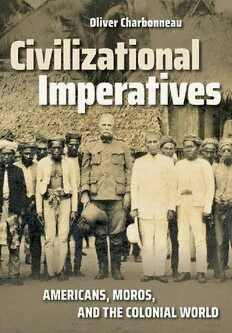
Civilizational Imperatives: Americans, Moros, and the Colonial World PDF
Preview Civilizational Imperatives: Americans, Moros, and the Colonial World
Civilizational Imperatives A VOLUME IN THE SERIES THE UNITED STATES IN THE WORLD founded by Mark Philip Bradley and Paul A. Kramer edited by Benjamin Coates, Emily Conroy-Krutz, Paul A. Kramer, and Judy Tzu-Chun Wu A list of titles in this series is available at cornellpress . cornell . edu. Civilizational Imperatives Americans, Moros, and the Colonial World Oliver Charbonneau Cornell University Press Ithaca and London Copyright © 2020 by Cornell University All rights reserved. Except for brief quotations in a review, this book, or parts thereof, must not be reproduced in any form without permission in writing from the publisher. For information, address Cornell University Press, Sage House, 512 East State Street, Ithaca, New York 14850. Visit our website at cornellpress.cornell.edu. First published 2020 by Cornell University Press Printed in the United States of Amer i ca Library of Congress Cataloging-i n- Publication Data Names: Charbonneau, Oliver, 1984– author. Title: Civilizational imperatives : Americans, Moros, and the colonial world / Oliver Charbonneau. Description: Ithaca [New York] : Cornell University Press, 2020. | Series: The United States in the world | Includes bibliographical references and index. Identifiers: LCCN 2020009191 (print) | LCCN 2020009192 (ebook) | ISBN 9781501750724 (hardcover) | ISBN 9781501750731 (pdf) | ISBN 9781501750748 (epub) Subjects: LCSH: Muslims—Philippines—History—20th century. | Imperialism—History—20th century. | Philippines—Colonization— History—20th century. | United States—Foreign relations— Philippines. | Philippines—Foreign relations—United States. Classification: LCC DS685 .C53 2020 (print) | LCC DS685 (ebook) | DDC 959.9/032—dc23 LC record available at https://lccn.loc.gov/2020009191 LC ebook record available at https://lccn.loc.gov/2020009192 Cover photograph: John Park Finley, governor of Zamboanga, attending the Convention of Moros at the Moro Exchange at Taluksangay, May 15–17, 1911. Burton Norvell Harrison Family Papers. Courtesy of the Library of Congress. For Victoria Just by saying that something was so, they believed that it was. I know now that these conquerors, like many others before them, and no doubt like others after, gave speeches not to voice the truth, but to create it. Laila Lalami, The Moor’s Account Contents List of Figures ix Acknowl edgments xi Note on Terminology and Transliteration xv Introduction: Other Frontiers 1 1. Imagining the Moro: Racial and Spatial Fantasies in Mindanao-S ulu 24 2. Courtrooms, Clinics, and Colonies: Remaking the Southern Philippines 49 3. Civilizational Imperatives: Building Colonial Classrooms 73 4. Corrective Vio lence: On Fear, Massacre, and Punishment 94 5. Tropical Idylls: Maintaining Colonial Spaces and Bodies 121 6. Moros in Amer i ca: Visiting the Metropole in Fact and Fiction 143 7. Imperial Interactivities: Mindanao- Sulu in a Connected World 168 Conclusion: Colonial Remains 199 Notes 207 Glossary 245 Bibliography 247 Index 273 Figures 0.1 Map of Mindanao and the Sulu Archipelago 11 0.2 Map of the Sulu Archipelago 12 1.1 “Mindanao, Moro Country” 42 2.1 Governor Frank W. Carpenter and Sultan Jamalul Kiram 55 3.1 Moro girls’ school in Cotabato 77 4.1 U.S. newspaper coverage of juramentado attacks 99 4.2 Aftermath of Bud Dajo massacre 108 5.1 U.S. Army officer’s collection of Moro weapons 134 6.1 Moro village, World’s Fair, St. Louis 148 6.2 A poster for George Ade’s The Sultan of Sulu 161 7.1 Map of colonized Southeast Asia 175 7.2 Datu Piang and retinue 183 7.3 John Finley and Moro leaders 193
